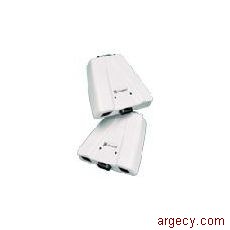Compsee Turbo Wedge
 | |
| Turbowedge 1 | Turbowedge 2 |
For all-around price and performance, the versatility of the TurboWedge provides the user with a multitude of features and functions. The use of state-of-the-art powerful and flexible Flash EPROM technology has allowed Compsee to develop a small footprint wedge that combines all the features of previous Compsee wedges with numerous new user-friendly program parameters.
The TurboWedge excels when it comes to input and output options. Input devices supported include bar code readers, Magnetic Stripe Readers and RS 232 input devices such as scales and portable terminals. Data passing through the TurboWedge can be decoded, edited and transmitted either as keyboard input or RS 232 ASCII. Wedge interface connections supported include all types of PC's and clones, as well as a variety f other terminals from DEC, IBM, HP, Wyse, etc.
Installation of he wedge is simple and fast, simply plug in between the keyboard and the terminal. For customization, the user can choose from seven different methods to program the TurboWedge set-up parameters. Added to the traditional menu and cloning methods is serial or bar code batch, bar code learn, on-screen or Compsee's Windows-based PC program, Win Cape.
As with all Compsee wedges, the TurboWedge contains powerful editing features that allow the user to qualify the data input, inhibit invalid data from passing through and then format the output of the data to match the applications input screen.
TurboWedge - Superior in Connectivity and Functionality
I N T E R F A C E O P T I O N S
RS 232............................ Single port, Dual port Keyboard Wedge terminal manufacturers supported (call for interface information to other terminals.)
TurboWedge 1............ PC, PS/2 and Clones IBM Apple Telex DEC
TurboWedge 2............ PC, PS/2 and Clones Hewlett Packard
Apple IBM
DEC Telex
Decision Data Wyse
I N P U T P O R T S
TurboWedge 1:
Port 1................................ Bar code scanners-laser, CCD, wand, etc.
Port 2................................ RS 232 input, magnetic stripe reader-single or dual track
TurboWedge 2:
Port 1................................. Bar code scanners-laser, CCD, wand, etc.
Port 2................................. RS 232 input, Bar code scanners-wand emulation
Port 3................................. Magnetic stripe reader-single, dual or triple track
I N P U T O P T I O N S
Bar Code Scanners:
Contact............................... Wands, bar code slots
Non-Contact.................... Lasers, CCD's, presentation scanners
Magnetic Stripe Readers.. Single track 1, 2 or 3 Dual track 1 & 2, 1 & 3, 2 & 3 Triple track 1, 2 & 3 (TurboWedge 2 only) RS 232 Auxilliary Input... Portable terminals, scales, slot scanners
B A R C O D E S Y M B O L O G I E S Auto-discriminates between the following symbologies:Code 3 of 9 Code 128 Code 3 of 9 Extended Code 93 UPC A Plessey UPC E EAN/JAN 8 Interleaved 2 of 5 EAN/JAN 13 Industrial 2 of 5 Code 11 Codabar
M E C H A N I C A L / E L E C T R I C A L
Weight .......................... 3.5 oz. (99.2 g)
Height........................... 1.10" (2.8 cm)
Length........................... 3.65" (9.3 cm)
Width........................... 3.75" (9.5 cm)
Enclosure....................... KJB flame retardent
Power Supply Options.... +5V to +14V supplied from the terminal or optional 9V power supply, which may be required in some cases
Output.......................... +5VDC10%
Current Draw................ 80 mA typical
Connectors..................... Port 1: 9-pin D male, squeeze to release
Port 2: 10-pin modular
Port 3: 10-pin modular
Power: 2-pin barrel
Interface: 15-pin D
E N V I R O N M E N T A L
Operating Temperature.... +32F to +122F (0C to +50C)
Storage Temperature........ -13F to +140F (-25C to +60C)
Humidity....................... 0% to 95% non-condensing
Electrostatic Discharge..... 15 KV to any external surface
EMC Regulations........... FCC and CE
P R O G R A M M O D E S
Program Modes ............... On-Screen Bar Code Learn
Bar Code Menu Win Cape
Bar Code Batch Serial Batch
Wedge Clone
P R O G R A M P A R A M E T E R S
Through programming the user has the ability to validate data input and
define the output format of the data.
General Parameters........... Terminal Type Keyboard Type
Foreign Keyboard Numeric Keypad
Buffer Enable Beeper Volume
Mag Track Select Solicit Record
Intercharacter Delay Interfunction delay
Set Pause Time Output Edited Records Only
Laser with Markerbeam Laser with Auto Sense
Turbo Mode
Bar Code Input Parameters.. Preamble CodeEnable/Disable
Postamble Code Length
Embedded Function Code Start/Stop Transmit
Code Identification Check Digit Checks
Redundancy Check Digit Transmit
Auto Scan UPC Code ID Transmit
Multi-Scan
Serial Parameters.............. Baud Rate Word Length
Parity Stop Bits
Record Terminator RS 232 Input Protocol
Flow Control Buffer Mode
Input Data Edit Parameter.. Qualify by Port Qualify by Symbology
Qualify by Length Qualify by Data Match
Output Data Edit Parameters Add Data Delete Data
Reformat Data Define Two Output Formats
Keyboard Mapping Parameters Single Key Positions Swap Two Keys
(Turbo Wedge 2 only) Function Records Multiple Key Positions
EXAMPLES OF USER EDIT PROGRAMMING
1. Qualify by Length, Symbology and two Match Positions
If Code 3 of 9, 12 digits, Position 4 = M and Position 7 = T Output Format
= Ignore Match Characters, Insert Tab and Enter
Input Record.................. 192M74T93842
Output Format.............. 192
2. Qualify by Symbology and 1 Match Position If Code 128, Variable Length,
Position 8 = 5 Output Format = Ignore Match Character, Insert Data and
Function Codes
Input Record................. 00433005920000223
Output Format.............. 0043300 5 920000223

